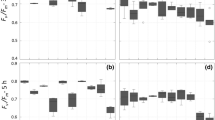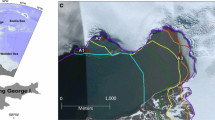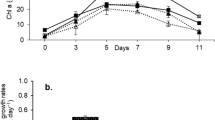Abstract
Environmental variations can have major consequences on photosynthesis and in turn impact the settlement, productivity, or survival of plants in the intertidal zones. Low tides in Hawaii fluctuate <1 m yet expose intertidal macroalgae to high tropical temperatures and irradiances, which are predicted to have negative physiological consequences. To better understand environmental variations, temperature, exposure duration, and irradiance were measured in two intertidal zones on O‘ahu over 8 days with negative tidal heights. Then to test whether these conditions were stressful, the photosynthetic response (via pulse amplitude modulated fluorometry) and relative water content of a common intertidal macroalgae, Padina sanctae-crucis, was measured over varying tidal heights. We found that P. sanctae-crucis was exposed to air from 0 to 6 h on days with tropical irradiance (237–2000 µmol photon m−2 s−1) and a range of temperatures (20.4–32.3 °C), yet plants were able to maintain relatively high water content. Photosynthetic parameters for P. sanctae-crucis derived from light response curves were found to vary with irradiance. High irradiances were associated with lowered maximum rates of electron transport (rETRmax) and effective quantum yield (Φ PSII). It was also determined that macroalgae exhibited different curves with tidal state. P. sanctae-crucis had relatively increased saturation irradiances (E k) and increased rETRmax but lowered effective quantum yield (Φ PSII) during negative tidal heights when aerial exposure is more common. P. sanctae-crucis was then exposed to air for up to 40 min in a laboratory experiment to determine the effect on fluorescence parameters. The 40-min aerial exposure, a duration smaller than which occurs at low tide, resulted in reduced rETRmax, α, and Φ PSII. This manipulation combined with field observations indicate that aggregations of thalli combined with water motion and minimal tidal fluctuations help to limit water loss and maintain photosynthetic rates. From these results, we can conclude, for this system, high irradiances are a major factor that likely limits production.




Similar content being viewed by others
References
Abbott IA (1999) Marine red algae of the Hawaiian Islands. Bishop Museum Press, Honolulu
Abbott IA, Huisman JM (2004) Marine green and brown algae of the Hawaiian Islands. Bishop Museum Press, Honolulu
Beach KS, Smith CM (1996a) Ecophysiology of tropical rhodophytes. II. Microscale acclimation in photosynthesis. J Phycol 32:710–718
Beach KS, Smith CM (1996b) Ecophysiology of tropical Rhodophytes. I. Microscale acclimation in pigmentation. J Phycol 32:701–710
Beach KS, Smith CM (1997) Ecophysiology of a tropical rhodophyte III. Recovery from emersion stresses in Ahnfeltiopsis concinna (J. Ag.) Silva et DeCew. J Exp Mar Biol Ecol 221:151–167
Beach KS, Borgeas HB, Smith CM (2006) Ecophysiological implications of the measurement of transmittance and reflectance of tropical seaweeds. Phycologia 45:450–457
Beer S, Axelsson L (2004) Limitations in the use of PAM fluorometry for measuring photosynthetic rates of macroalgae at high irradiances. Eur J Phycol 39:1–7
Beer S, Bjork M (2000) Measuring rates of photosynthesis of two tropical seagrasses by pulse amplitude modulated (PAM) fluorometry. Aquat Bot 66:69–76
Beer S, Eshel A (1983) Photosynthesis of Ulva sp. I. Effects of desiccation when exposed to air. J Exp Mar Biol Ecol 70:91–97
Beer SB, Vilenkin A, Weil M, Veste L, Eshel S (1998) Measuring photosynthetic rates in seagrasses by pulse amplitude modulated (PAM) fluorometry. Mar Ecol Prog Ser 174:293–300
Beer S, Bjork M, Gademann R, Ralph PJ (2001) Measurements of photosynthesis in seagrasses. In: Short FT, Coles R (eds) Global seagrass research methods. Elsevier Publishers, The Netherlands, pp 183–198
Bell EC (1992) Consequences of morphological variation in an intertidal macroalga: physical constraints on growth and survival of Mastocarpus papillatus Kutzing. Dissertation, Standford University
Bell EC (1995) Environmental and morphological influences on thallus temperature and desiccation of the intertidal alga Mastocarpus papillatus Kutzing. J Exp Mar Biol Ecol 191:29–55
Bertness MD, Leonard GH, Levine JM, Schmidt PR, Ingraham AO (1999) Testing the relative contribution of positive and negative interactions in rocky intertidal communities. Ecology 80:2711–2726
Bird CE, Franklin EC, Smith CM, Toonen RJ (2013) Between tide and wave marks: a unifying model of physical zonation on littoral shores. PeerJ 1:e154
Boardman K (1977) Comparative photosynthesis of sun and shade plants. Ann Rev Plant Physiol 28:355–377
Büchel C, Wilhelm C (1993) In vivo analysis of slow chlorophyll fluorescence induction kinetics in algae: progress, problems and perspectives. Photochem Photobiol 58:137–148
Chapman ARO (1995) Functional ecology of fucoid seaweeds: twenty-three years of progress. J Phycol 32:197–211
Ciais P, Sabine C, Bala G, Bopp L, Brovkin V, Canadell J, Chhabra A, DeFries R, Galloway J, Heimann M, Jones C, Le Quéré C, Myneni RB, Piao S, Thornton P (2013) Carbon and Other biogeochemical cycles. In: Stocker TF, Qin D, Plattner G-K, Tignor M, Allen SK, Boschung J, Nauels A, Xia Y, Bex V, Midgley PM (eds) Climate change 2013: the physical science basis contribution of Working Group I to the Fifth Assessment Report of the Intergovernmental Panel on Climate Change, Cambridge University Press, Cambridge, United Kingdom and New York, NY, USA
Colvard NB, Carrington E, Helmuth B (2014) Temperature-dependent photosynthesis in the intertidal alga Fucus gardneri and sensitivity to ongoing climate change. J Exp Mar Biol Ecol 458:6–12
Connell JH (1961) The influence of intra-specific competition and other factors on the distribution of the barnacle Chthamalus stellatus. Ecology 42:710–723
Cox TE, (2011) Aspects of ecology and algal physiology in Hawaii’s rocky intertidal zones. Dissertation University of Hawaii, Department of Botany, Honolulu, Hawaii. p 233
Cox TE, Smith CM (2011) Thermal ecology on an exposed algal reef: infrared imagery a rapid tool to survey temperature at local spatial scales. Coral Reefs 30:1109–1120
Cox TE, Philippoff J, Baumgartner E, Zabin CJ, Smith CM (2013) Spatial and temporal variation in rocky intertidal communities along the Main Hawaiian Islands. Pac Sci 67:23–45
Davison IR, Pearson GA (1996) Stress tolerance in intertidal seaweeds. J Phycol 32:197–211
Davison IR, Johnson LE, Brawley SH (1993) Sublethal stress in the intertidal zone: tidal emersion inhibits photosynthesis and retards development in embryos of the brown alga Pelvetia fastigiata. Oecologia 96:483–492
Delebecq G, Davoult D, Menu DE, Joaquin M-A, Migné A, Dauvin J-C, Gevaert F (2011) In situ photosynthetic performance of Laminaria digitata (Phaeophyceae) during spring tides in Northern Brittany. Cah Mar Biol 52:1–10
Demmig-Adams B, Adams WWI (1996) The role of xanthophyll cycle carotenoids in the protection of photosynthesis. Trends Plant Sci 1:21–26
Dethier MN, Williams SL (2009) Seasonal stresses shift optimal intertidal algal habitats. Mar Biol 156:555–567
Dethier MN, Williams SL, Freeman A (2005) Seaweeds under stress: manipulated stress and herbivory affect critical life-history functions. Ecol Monogr 75:403–418
Doty MS (1946) Critical tide factors that are correlated with the vertical distribution of marine seaweeds and other organisms along the Pacific Coast. Ecology 27:315–328
Dring MJ, Brown FA (1982) Photosynthesis of intertidal brown seaweeds during and after periods of emersion: a renewed search for physiological causes of zonation. Mar Ecol Prog Ser 8:301–308
Dring MJ, Makarov V, Schoschina E, Lorenz M, Lüning K (1996) Influence of ultraviolet-radiation on chlorophyll fluorescence and growth in different life-history stages of three species of Laminaria (Phaeophyta). Mar Biol 126:183–191
Dudgeon SR, Kubler JE, Vadas RL, Davison IR (1995) Physiological responses to environmental variation in intertidal red seaweeds: does thallus morphology matter? Mar Ecol Prog Ser 117:193–206
Foster MS (1982) Factors controlling the intertidal zonation of Iridaea flaccida (Rhodophyta). J Phycol 18:285–294
Ganzon-Fortes ET (1997) Influence of tidal location on morphology, photosynthesis and pigments of the agarophyte, Gelidiella acerosa, from Northern Philippines. J Appl Phycol 9:525–532
Gao K, Ji Y, Aruga Y (1999) Relationship of CO2 concentrations to photosynthesis of intertidal macroalgae during emersion. Hydrobiologia 398(399):355–359
Genty B, Briantais JM, Baker NR (1989) The relationship between the quantum yield of photosynthetic electron transport and quenching of chlorophyll fluorescence. Biochim Biophys Acta 990:87–92
Gévaert F, Créach A, Davoult D, Migné A, Levavasseur G, Arzel P, Holl A-C, Lemoine Y (2003) Laminaria saccharina photosynthesis measured in situ: photoinhibition and xanthophyll cycle during a tidal cycle. Mar Ecol Prog Ser 247:43–50
Gosline WA (1965) Vertical zonation of inshore fishes in the upper water layers of the Hawaiian Islands. Ecology 46:823–831
Hanelt D, Huppertz K, Nultsch W (1993) Daily course of photosynthesis and photoinhibition in marine macroalgae investigated in the laboratory and field. Mar Ecol Prog Ser 97:31–37
Harrison WG, Platt T (1986) Photosynthesis-irradiance relationships in polar and temperate phytoplankton populations. Polar Biol 5:153–164
Hay ME (1981) The functional morphology of turf-forming seaweeds: persistence in stressful marine habitats. Ecology 62:739–750
Helmuth BS (2009) From cells to coastlines: how can we use physiology to forecast the impacts of climate change? J Exp Biol 212:753–760
Helmuth BS, Hoffmann GE (2001) Microhabitats, thermal heterogeneity, and patterns of physiological stress in the rocky intertidal zone. Biol Bull 210:374–384
Henley WJ (1999) Measurement and interpretation of photosynthetic light response curves in algae in the context of photoinhibition and diel changes. J Phycol 29:729–739
Henley WJ, Levavasseur G, Franklin LA, Lindley ST, Ramus J, Osmond CB (1991) Diurnal responses of photosynthesis and fluorescence in Ulva rotundata acclimated to sun and shade in outdoor culture. Mar Ecol Prog Ser 75:19–28
Hunt LJH, Denny MW (2008) Desiccation protection and disruption: a trade-off for an intertidal marine alga. J Phycol 44:1164–1170
Ihnken S, Eggert A, Beardall J (2010) Exposure times in rapid light curves affect photosynthetic parameters in algae. Aquat Bot 93:185–194
Johnson WS, Gigon A, Gulmon SL, Mooney HA (1974) Comparative photosynthetic capacities of intertidal seaweeds under exposed and submerged conditions. Ecology 55:450–453
Kay AE (1979) Hawaiian marine shells, reef and shore fauna of Hawaii. Bishop Museum Press, Honolulu
Laviale M, Prygiel J, Lemoine Y, Courseaux A, Cre´ach A (2009) Stream periphyton photoacclimation response in field conditions: effect of community development and seasonal changes. J Phycol 45:1072–1082
Longstaff B, Kildea T, Runcie J, Cheshire A, Dennison WC, Hurd C, Kana T, Raven JA, Larkum AWD (2002) An in situ study of photosynthetic oxygen exchange and electron transport rate in the marine macroalgae Ulva lactuca (Chlorophyta). Photosynth Res 74:281–293
Matta JL, Chapman DJ (1995) Effects of light, temperature, and desiccation on the net emersed productivity of the intertidal macroalga Colpomenia peregrina Sauv. (Hamel). J Exp Mar Biol Ecol 189:13–27
Maxwell K, Johnson GN (2000) Chlorophyll fluorescence-a practical guide. J Exp Bot 51:659–668
Molina-Montenegro MA, Munoz AA, Badano EI, Morales BV, Fuentes KM, Cavieres LA (2005) Positive associations between macroalgal species in a rocky intertidal zone and their effects on the physiological performance of Ulva lactuca. Mar Ecol Prog Ser 292:173–180
Oates BR, Murray SN (1983) Photosynthesis, dark respiration and desiccation resistance of the intertidal seaweeds Hesperophycus harveyanus and Pelvetia fastigiata F. gracilis. J Phycol 19:371–380
Paine RT (1974) Intertidal community structure: experimental studies on the relationship between a dominant competitor and its principal predator. Oecologia 15:93–120
Platt T, Gallegos CL, Harrison WG (1980) Photoinhibition of photosynthesis in natural assemblages of marine phytoplankton. J Mar Res 38:687–701
Ralph PJ, Gademann R (2005) Rapid light curves: a powerful tool to assess photosynthetic activity. Aquat Bot 82:222–237
Schaffelke B, Deane D (2005) Desiccation tolerance of the introduced marine green alga Codium fragile ssp. tomentosoides—clues for likely transport vectors. Biol Invasions 7:557–565
Schonbek M, Norton TA (1978) Factors controlling the upper limits of fucoid seaweed on the shore. J Exp Biol Ecol 31:303–313
Silva J, Santos R, Calleja ML, Duarte CM (2005) Submerged versus air-exposed intertidal macrophyte productivity: from physiological to community-level assessments. J Exp Mar Biol Ecol 317:87–95
Smith CM, Berry JA (1986) Recovery of photosynthesis after exposure of intertidal seaweeds to osmotic and temperature stresses: comparative studies of species with differing distributional limits. Oecologia 70:6–12
Tait LW, Schiel DR (2010) Primary productivity of intertidal macroalgal assemblages: comparison of laboratory and in situ photorespirometry. Mar Ecol Prog Ser 416:115–125
Tomanek L, Helmuth BS (2002) Physiological ecology of rocky intertidal organisms: a synergy of concepts. Integr Comp Biol 42:771–775
White AJ, Critchley C (1999) Rapid light curves: a new fluorescence method to assess the state of the photosynthetic apparatus. Photosynth Res 59:63–72
Williams SL, Dethier MN (2005) High and dry: variation in net photosynthesis of the intertidal seaweeds Fucus gardneri. Ecology 86:2373–2379
Wright JT, Williams SL, Dethier MN (2004) No zone is always greener: variation in the performance of Fucus gardneri embryos, juveniles and adults across tidal zone and season. Mar Biol 145:1061–1073
Acknowledgments
We would like to thank Mailie Rechirei, Drs. Chris Bird and Kelly Boyle, and members of UH’s 2010 Botany 180 class for their assistance with data collection. Further, we thank Drs. Alison Sherwood, Peter Vroom, Dave Carlon, Brian Popp, and multiple reviewers for their edits and suggestions for this manuscript.
Author information
Authors and Affiliations
Corresponding author
Additional information
Communicated by R. Hill.
Electronic supplementary material
Below is the link to the electronic supplementary material.
Rights and permissions
About this article
Cite this article
Cox, T.E., Smith, C.M. Photosynthetic rapid light curves for Padina sanctae-crucis vary with irradiance, aerial exposure, and tides in Hawaii’s micro-intertidal zones. Mar Biol 162, 1061–1076 (2015). https://doi.org/10.1007/s00227-015-2649-1
Received:
Accepted:
Published:
Issue Date:
DOI: https://doi.org/10.1007/s00227-015-2649-1




